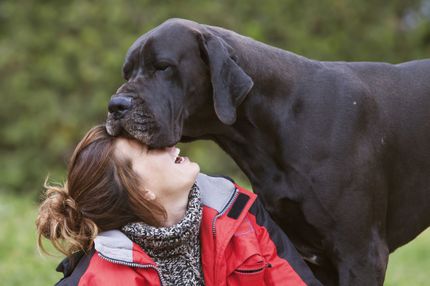Facts & Origin
Foxhoodle: The amiable mix of English Foxhound and Poodle.
The Foxhoodle is a charming mixed breed that is made up of the quick and sturdy English Foxhound and the intelligent and playful Poodle. This breed boasts a lively personality, intelligence and adaptable nature and is an ideal pet for those looking for an active, family-friendly dog.
Origin and History
The Foxhoodle is a product of two recognized breeds with rich histories. The English Foxhound has deep roots in Britain and was bred for fox hunting. The Poodle, on the other hand, has European roots and was originally used as a water dog. This mixed breed benefits from both, combining the eagerness of the Foxhound and the intelligence of the Poodle into one package.
In summary, the Foxhoodle is a lovable, energetic and family-friendly dog that will fit into any active family. His adaptable and studious nature, combined with his need for exercise, makes him an asset to any home that can accommodate his needs.
| Alternate Name | - |
| Origin | UK - Germany |
| Life expectancy | 10 - 15 years |
| Care requirements | low-maintenance - high-maintenance |
| Activity level | high - average to high |
| FCI group | not recognised |
| AKC group | not recognised |
| KC group | not recognised |
More English foxhound mixes
More Poodle mixes
Attitude, character and temperament of the breed
Possible character traits
With a Foxhound and Poodle as parents, the Foxhoodle brings with it a whole range of positive traits. These dogs are known for their friendliness, intelligence and adaptability. They love to be active and enjoy various types of physical activity, from running to playing. Thanks to the Poodle's intelligence, Foxhoodles are also quite easy to train and learn new commands and tricks quickly.
Suitability and attitude
Thanks to their friendly nature and high energy, Foxhoodles are great for active families. They make great companions for children and usually get along well with other pets. However, since they are quite energetic, they need a large enough living space and plenty of time to play and exercise.
Character
Usage
Care and health
The Foxhoodle's health can be affected by the health predispositions of both parent breeds. Therefore, regular vet visits to monitor their health are crucial. Coat care depends on the individual dog and can vary from short and smooth to curly and thick. In general, they require regular brushing to prevent matting and skin problems.
What does this mixed breed look like?
A Foxhoodle is a medium to large breed, depending on the size of the Poodle parent. They usually have an athletic build, inherited from the English Foxhound, and may have the curly hair of the Poodle. Coat colors can vary greatly, including black, white, brown, and mixtures of these colors.
Known Diseases
Ataxia
Ataxia (from Greek ἀταξία ataxia 'disorder' 'irregularity') is a generic term in medicine for various disorders of movement coordination. Ataxia can occur even when there is no paralysis (paresis), that is, when there is normal muscle strength.
Epilepsy
Definition: Dog has epilepsy if, for example, at least two epileptic seizures occur more than 24 hours apart.
Cataract
Cataracts are still one of the most common causes of blindness, even in dogs.
Progressive Retinal Atrophy (PRA)
Progressive retinal atrophy (PRA) is a slowly progressive death of the retina in dogs.
Patellar problems
Problems with the Patellar can be a displacement or weak kneecap, which is one of the most common causes of lameness in dogs, also because of overweight.
Eye diseases
Often occur with allergies and intolerances.
FAQ
-
Foxhoodles are intelligent, curious and playful dogs. They have an energetic temperament and are very active. They are well suited for families with active members and are usually well behaved with both adults and children.
-
The average life expectancy is 10 to 14 years.
-
These mixed breed dogs require moderate care. It is also important that they get enough exercise and run.
-
Regular training is important to ensure they remain obedient. They also need continuous stimulation to keep their minds healthy.
-
No, but the diet should be adapted to their size, activity level and age.




















